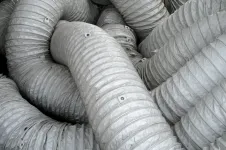New snailfish genome reveals how they adapted to the pressures of deep-sea life
The genome contains extra genes for enzymes that help stabilize its proteins and DNA under high pressures
2021-05-13
(Press-News.org) A new whole genome sequence for the Yap hadal snailfish provides insights into how the unusual fish survives in some of the deepest parts of the ocean. Xinhua Chen of the Fujian Agriculture and Forestry University and Qiong Shi of the BGI Academy of Marine Sciences published their analysis of the new genome May 13th in the journal PLOS Genetics.
Animals living in deep-sea environments face many challenges, including high pressures, low temperatures, little food and almost no light. Fish are the only animals with a backbone that live in the hadal zone--defined as depths below 6,000 meters--and hadal snailfishes live in at least five separate marine trenches. Chen, Shi and their colleagues constructed a high-quality whole genome sequence from the Yap hadal snailfish to understand how it has adapted to life in the deep sea. The fish was captured from the Yap Trench in the western Pacific Ocean at a depth of about 7,000 meters.
Analysis of the new genome revealed multiple adaptations for living in a cold, dark, high-pressure environment. The snailfish carries extra genes for DNA repair, which may help keep its genome intact under high pressures. It also has five copies of a gene for an enzyme that takes a compound produced by bacteria in its gut and transforms it into one that stabilizes the structure of proteins under high hydrostatic pressure. The snailfish has also lost certain genes involved in vision, taste and smell, which are likely unnecessary in its dark, food-limited environment.
These new findings offer clues into the mechanisms that snailfish have evolved to survive in oceanic trenches. However, the researchers point out that further studies will be needed to confirm the functions of these genetic changes. Additionally, the high-quality genome sequence can serve as a resource for future in-depth investigations of snailfish and other animals living in the hadal zone.
Chen adds, "Many genes associated with DNA repair show evidence of positive selection and have expanded copy numbers in the genome of Yap hadal snailfish, which potentially reflect the difficulty of maintaining DNA integrity under high hydrostatic pressure. The five copies of the trimethylamine N-oxide (TMAO)-generating enzyme flavin-containing monooxygenase-3 gene (fmo3) and the abundance of trimethylamine (TMA)-generating bacteria in the gut of Yap hadal snailfish could provide enough TMAO to improve protein stability under hadal conditions."
INFORMATION:
Peer-reviewed; Experimental study; Animals
In your coverage please use this URL to provide access to the freely available article in PLOS Genetics:
http://journals.plos.org/plosgenetics/article?id=10.1371/journal.pgen.1009530
Citation: Mu Y, Bian C, Liu R, Wang Y, Shao G, Li J, et al. (2021) Whole genome sequencing of a snailfish from the Yap Trench (~7,000 m) clarifies the molecular mechanisms underlying adaptation to the deep sea. PLoS Genet 17(5): e1009530. https://doi.org/10.1371/journal.pgen.1009530
Funding: This work was supported by grants from National Key R&D Program of China (2018YFD0900602; https://service.most.gov.cn) to Y.M., and National Program on the Key Basic Research Project (2015CB755903; https://service.most.gov.cn), China Agriculture Research System (CARS-47; http://www.cars.ren), China Ocean Mineral Resources R&D Association Program (DY135-B2-16; http://www.comra.org), and Special Fund for Marine Economic Development of Fujian Province (FJHJF-L-2019-2; https://hyyyj.fujian.gov.cn/) to X.C. The funders had no role in study design, data collection and analysis, decision to publish, or preparation of the manuscript.
Competing Interests: The authors have declared that no competing interests exist.
[Attachments] See images for this press release:

ELSE PRESS RELEASES FROM THIS DATE:
2021-05-13
Artificial intelligence (AI) learning machines can be trained to solve problems and puzzles on their own instead of using rules that we made for them. But often, researchers do not know what rules the machines make for themselves. Cold Spring Harbor Laboratory (CSHL) Assistant Professor Peter Koo developed a new method that quizzes a machine-learning program to figure out what rules it learned on its own and if they are the right ones.
Computer scientists "train" an AI machine to make predictions by presenting it with a set of data. The machine extracts a series of rules and operations--a model--based on information it encountered during its training. Koo says:
"If you learn general ...
2021-05-13
QUT air-quality expert Distinguished Professor Lidia Morawska is leading an international call for a "paradigm shift" in combating airborne pathogens such as COVID-19, demanding universal recognition that infections can be prevented by improving indoor ventilation systems.
Professor Morawska led a group of almost 40 researchers from 14 countries in a call published in Science for a shift in standards in ventilation requirements equal in scale to the transformation in the 1800s when cities started organising clean water supplies and centralised sewage systems.
The international group of air quality researchers called on the World ...
2021-05-13
For decades, governments worldwide have invested great deals of legislation and resources in food safety, sanitation and drinking water quality for public health purposes. However, the same cannot be said for the air quality of indoor public spaces, wherein the spread of airborne pathogens - whether those that cause the common cold or COVID-19 - is generally considered to be an "inescapable part of daily life." In a Policy Forum, Lidia Morawska and colleagues argue for a profound shift in how policymakers and building engineers view and approach indoor air quality and health, to reduce the spread of respiratory infection. According to Morawska et al., similarly to how food and waterborne disease ...
2021-05-13
A subpopulation of neurons in the brain's zona incerta, or "zone of uncertainty," drives investigatory and novelty-seeking behavior in mice, according to a new study. The findings reveal a previously unknown brain circuit underlying innate curiosity; its discovery may one day have implications as a therapeutic target in animals or people who exhibit novelty-seeking behaviors, authors of a related Perspective say. Although curiosity - the motivational drive to investigate the unknown - is widely considered to be as intrinsic as hunger and thirst, and an ...
2021-05-13
Challenging the assumption that watershed streamflow always recovers from drought, a new study done seven years after the "Millennium Drought," the worst drought ever recorded in southeastern Australia, reports that more than a third of the region's affected watersheds had not yet recovered. Of these watersheds that were still dry seven years later, most showed no evidence of recovering soon, despite the rains' return. The new study's findings suggest that hydrological droughts can persist indefinitely after meteorological droughts, highlighting an amplification of climate change impacts that could present additional challenges to the sustainable use of already-threatened water ...
2021-05-13
More investigation is needed to determine the origin of the COVID-19 pandemic, say Jesse Bloom, Alina Chan, Ralph Baric, David Relman and colleagues in this Letter. "Theories of accidental release from a lab and zoonotic spillover both remain viable," they say. "Knowing how COVID-19 emerged is critical for informing global strategies to mitigate the risk of future outbreaks." The authors highlight a joint China-World Health Organization (WHO) report into the origins of SARS-CoV-2, some results of which were released in November 2020. "WHO Director-General Tedros Ghebreyesus commented that the report's consideration of evidence supporting a laboratory ...
2021-05-13
Humans in the 21st century spend most of their time indoors, but the air we breathe inside buildings is not regulated to the same degree as the food we eat and the water we drink. A group of 39 researchers from 14 countries, including two from the University of Colorado Boulder, say that needs to change to reduce disease transmission and prevent the next pandemic.
In a Perspectives piece published in Science May 14, they call for a "paradigm shift" in combating airborne pathogens such as SARS-CoV-2, the virus that causes COVID-19, demanding universal recognition that respiratory infections can be prevented by improving indoor ventilation systems.
"Air can contain viruses just as water and surfaces do," said co-author Shelly Miller, professor of mechanical and ...
2021-05-13
UNIVERSITY PARK, Pa. -- A plant cell wall's unique ability to expand without weakening or breaking--a quality required for plant growth--is due to the movement of its cellulose skeleton, according to new research that models the cell wall. The new model, created by Penn State researchers, reveals that chains of cellulose bundle together within the cell wall, providing strength, and slide against each other when the cell is stretched, providing extensibility.
The new study, which appears online May 14 in the journal Science, presents a new concept of the plant cell wall, gives insights into plant cell growth, and could provide inspiration for the design of polymeric materials with new properties.
"For a long time, the prevailing ...
2021-05-13
Curiosity is the motivational drive for exploring and investigating the unknown and making new discoveries. It is as essential and intrinsic for survival as hunger. Until recently, the brain mechanisms underlying curiosity and novelty seeking behavior were unclear. However, researchers from the Netherlands Institute for Neuroscience have now discovered a new brain circuit underlying curiosity and novelty seeking behavior. The results have been published in the scientific journal Science.
Curiosity, hunger and appetitive aggression drive three different goal-directed behaviors: novelty seeking, food eating and hunting. In animals these behaviors are composed of similar actions. This similarity of actions has made it challenging ...
2021-05-13
A group of the world's leading experts in the transmission of airborne pathogens is calling for a tightened regulatory system to control air quality in buildings - as a way of reducing the spread of covid-19 and other illnesses.
Writing in the journal Science, the 40 scientists say: "A paradigm shift is needed on the scale that occurred when Chadwick's Sanitary Report in 1842 led the British government to encourage cities to organise clean water supplies and centralised sewage systems.
"In the 21st century we need to establish the foundations to ensure that the air in our buildings is clean with a significantly reduced ...
LAST 30 PRESS RELEASES:
[Press-News.org] New snailfish genome reveals how they adapted to the pressures of deep-sea life
The genome contains extra genes for enzymes that help stabilize its proteins and DNA under high pressures



